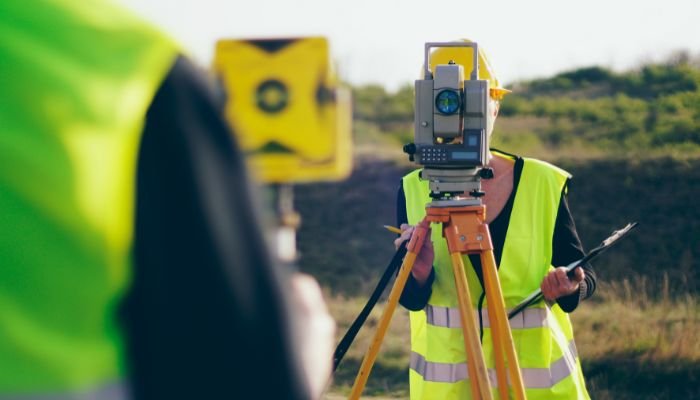Surveying, a key aspect of modern infrastructure and development, takes many forms that are suited to the specific needs of various projects. Geodetic surveying and plane surveying are the two main branches of this science, each with its own set of methodology and uses. This article delves into the specifics of these two surveying disciplines, highlighting their contrasts and distinct strengths.
Geodetic Surveying: Geodetic surveying is a specialized field focused on measuring and representing the Earth’s surface on a global scale. Geodetic surveyors, whose name is derived from the Greek words “geo” (Earth) and “dais” (to divide), carefully analyze aspects such as the curvature of the Earth and gravity. They employ ellipsoidal models, with the World Geodetic System (WGS84) being a common choice.
Geodetic surveys, which frequently include technology such as GPS, cover large areas while creating precise control points. The major goal is to develop a worldwide framework for mapping and navigation that will be essential for applications such as satellite communication, global navigation systems, and international boundary determination.
Plane Surveying: In contrast, plane surveying, also known as flat-earth surveying, operates on a smaller scale, assuming a flat Earth surface within the surveyed area. This simplification is useful for projects when the area is modest in comparison to the curvature of the Earth.
Plane surveyors, who are typically engaged in local tasks such as property surveys and construction layouts, employ Cartesian coordinates, ignoring Earth’s curvature and gravitational anomalies. This simplifies computations and speeds up the surveying process, making it more appropriate for smaller-scale activities such as topographic mapping of restricted areas.
| 01 | The earth surface is considered as plain surface | The earth surface is considered as curved surface |
| 02 | The Curvature of the earth is ignored | The Curvature of the earth is taken into account |
| 03 | Line joining any two stations is considered to be straight | The line joining any station is considered as spherical |
| 04 | Survey accuracy is low | Survey accuracy is high |
| 05 | Carried out for a small area of <250 km | Carried out for a small area of >250 km |
| 06 | The triangle formed by any three points is considered as plain | The triangle formed by any three points is considered as spherical |
| 07 | Plane surveying uses normal instruments like chain, measuring tape, theodolite etc. | Geodetic surveying uses more precise instruments and modern technology like GPS. |
What are the assumptions made in plane surveying?
Flat Earth Surface
Plane surveying is based on the assumption that the Earth’s surface is flat over the area being surveyed. This assumption holds true for relatively small regions where the curvature of the Earth is negligible. It makes calculations easier by employing two-dimensional Cartesian coordinate systems (X, Y) rather than more sophisticated three-dimensional coordinates.
Localized Gravity
Plane surveying is based on the assumption that gravity acts uniformly and vertically throughout the examined area. This means that variations in elevation have no effect on the gravitational force acting on the survey measurements. In truth, gravity varies with latitude and elevation, but these fluctuations are regarded as unimportant in small areas.
Straight Sight Lines
Another simplification in plane surveying is the assumption of straight-sight lines between survey stations. Surveyors employ straight-line measurements between points because they presume light travels in straight lines. This assumption holds true for short distances within the scope of the study.
Neglect of Atmospheric Refraction
Plane surveying frequently ignores the effects of atmospheric refraction, which can cause light rays to bend. While this assumption is valid for short distances, it becomes less accurate for longer sight lines. For exact readings over wider areas, air refraction is carefully examined in geodetic surveying.
Cartesian Coordinate System
Plane surveying uses a two-dimensional Cartesian coordinate system (X, Y) to measure distances horizontally along a flat surface. This simplification does not take into account ellipsoidal heights or fluctuations in the third dimension (Z-axis) induced by the curvature of the Earth.
Local Datum
Plane surveying frequently refers to a local datum rather than a global coordinate system. Within the surveyed area, a local datum is established and used as the reference for all measurements. Geodetic surveying, on the other hand, use global datums that account for the curvature of the Earth on a bigger scale.
Small-Angle Approximation
When measuring angles in plane surveying, the small-angle approximation is frequently used. This assumes that angles are small enough to be handled as linear, making trigonometric calculations easier. This approximation is appropriate for small areas, but it may cause mistakes in larger-scale surveys.
What are the assumptions made in geodetic surveying?
Earth is an Ellipsoid
Geodetic surveying assumes that an ellipsoid, a three-dimensional shape obtained by rotating an ellipse about its minor axis, best represents the Earth. The World Geodetic System (WGS84) ellipsoid is a common ellipsoid. This assumption allows for a more accurate representation of the Earth’s shape compared to a simple sphere.
Gravitational Variations
Geodetic surveying takes gravitational acceleration changes over the Earth’s surface into consideration. Gravity is not uniform, and it varies due to factors such as the distribution of mass on Earth. To account for these gravitational fluctuations, precise measurements and corrections are used.
Three-Dimensional Coordinate System
Geodetic surveying use a three-dimensional coordinate system to properly depict places on the Earth’s surface. Latitude, longitude, and ellipsoidal height are all included. When compared to the two-dimensional Cartesian system used in planar surveying, these coordinates provide a more thorough description of a point’s location.
The curvature of the Earth
Geodetic surveying takes the curvature of the Earth into account explicitly. The impact of the Earth’s curvature grows increasingly important as survey data are extended across bigger areas. Measurements are corrected to account for this curvature, ensuring positioning accuracy.
Global Datums
Geodetic surveys are frequently linked to global datums, which serve as a reference framework for locating on a worldwide scale. To establish a consistent reference for geodetic measurements, datums such as WGS84 or North American Datum 1983 (NAD83) are used. These datums take into account the shape of the Earth as well as gravitational variations.
Satellite Innovative ideas
Satellite-based positioning systems, such as the Global Positioning System (GPS), are frequently used in geodetic surveying. These systems provide precise control points and measurements over long distances by providing accurate and global positioning data.
Distortion in Map Projections
When creating maps from geodetic measurements, distortion must be taken into account. Distortions in shape, area, distance, or direction are introduced by different map projections. Geodetic surveyors choose map projections based on project requirements, balancing the type and extent of distortion.
Spherical Trigonometry
To calculate distances, angles, and areas on the Earth’s surface, geodetic surveying uses spherical trigonometry. When dealing with spherical or ellipsoidal geometry, this type of trigonometry is required to ensure accurate measurements over long distances.
Final Words
In conclusion, while geodetic surveying and plane surveying have the same goal of collecting spatial data, their applications and methodology differ greatly. The worldwide framework required for large-scale projects and international navigation systems is provided by geodetic surveying.
Plane surveying, on the other hand, simplifies computations by assuming a level Earth surface, making it suitable for smaller, more localized projects. The magnitude and nature of the project dictate which surveying methods are used, emphasizing the versatility and adaptability of surveying techniques in shaping our linked world.
FAQs
Geodetic surveying is well suited to large-scale projects spanning major geographic areas, such as international boundary determination, satellite navigation systems, and global mapping.
While plane surveying is accurate for small-scale projects, its assumptions about a flat Earth surface can cause measurement inaccuracies in bigger projects where the curvature of the Earth becomes relevant.
Geodetic and plane surveying are both adaptable, but their usefulness is determined by the project’s size and nature. Geodetic surveying is essential for global accuracy, while plane surveying is practical for smaller, localized endeavors.
Geodetic surveyors consider the Earth’s curving surface to be best represented by an ellipsoid, whereas plane surveyors simplify computations by treating the Earth’s surface as flat within the surveyed area.




